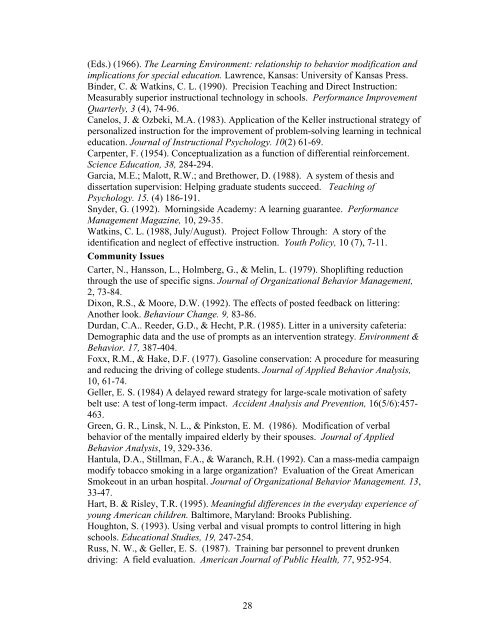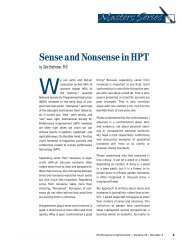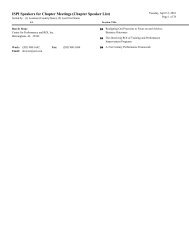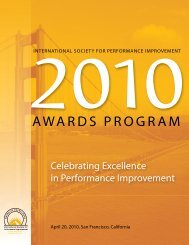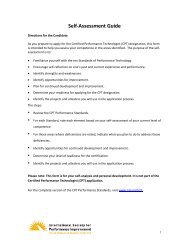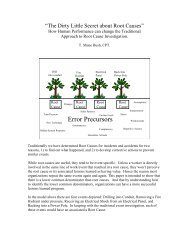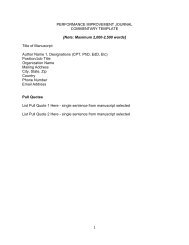Yes We Can! - International Society for Performance Improvement
Yes We Can! - International Society for Performance Improvement
Yes We Can! - International Society for Performance Improvement
Create successful ePaper yourself
Turn your PDF publications into a flip-book with our unique Google optimized e-Paper software.
(Eds.) (1966). The Learning Environment: relationship to behavior modification and<br />
implications <strong>for</strong> special education. Lawrence, Kansas: University of Kansas Press.<br />
Binder, C. & Watkins, C. L. (1990). Precision Teaching and Direct Instruction:<br />
Measurably superior instructional technology in schools. Per<strong>for</strong>mance <strong>Improvement</strong><br />
Quarterly, 3 (4), 74-96.<br />
<strong>Can</strong>elos, J. & Ozbeki, M.A. (1983). Application of the Keller instructional strategy of<br />
personalized instruction <strong>for</strong> the improvement of problem-solving learning in technical<br />
education. Journal of Instructional Psychology. 10(2) 61-69.<br />
Carpenter, F. (1954). Conceptualization as a function of differential rein<strong>for</strong>cement.<br />
Science Education, 38, 284-294.<br />
Garcia, M.E.; Malott, R.W.; and Brethower, D. (1988). A system of thesis and<br />
dissertation supervision: Helping graduate students succeed. Teaching of<br />
Psychology. 15. (4) 186-191.<br />
Snyder, G. (1992). Morningside Academy: A learning guarantee. Per<strong>for</strong>mance<br />
Management Magazine, 10, 29-35.<br />
Watkins, C. L. (1988, July/August). Project Follow Through: A story of the<br />
identification and neglect of effective instruction. Youth Policy, 10 (7), 7-11.<br />
Community Issues<br />
Carter, N., Hansson, L., Holmberg, G., & Melin, L. (1979). Shoplifting reduction<br />
through the use of specific signs. Journal of Organizational Behavior Management,<br />
2, 73-84.<br />
Dixon, R.S., & Moore, D.W. (1992). The effects of posted feedback on littering:<br />
Another look. Behaviour Change. 9, 83-86.<br />
Durdan, C.A.. Reeder, G.D., & Hecht, P.R. (1985). Litter in a university cafeteria:<br />
Demographic data and the use of prompts as an intervention strategy. Environment &<br />
Behavior. 17, 387-404.<br />
Foxx, R.M., & Hake, D.F. (1977). Gasoline conservation: A procedure <strong>for</strong> measuring<br />
and reducing the driving of college students. Journal of Applied Behavior Analysis,<br />
10, 61-74.<br />
Geller, E. S. (1984) A delayed reward strategy <strong>for</strong> large-scale motivation of safety<br />
belt use: A test of long-term impact. Accident Analysis and Prevention, 16(5/6):457-<br />
463.<br />
Green, G. R., Linsk, N. L., & Pinkston, E. M. (1986). Modification of verbal<br />
behavior of the mentally impaired elderly by their spouses. Journal of Applied<br />
Behavior Analysis, 19, 329-336.<br />
Hantula, D.A., Stillman, F.A., & Waranch, R.H. (1992). <strong>Can</strong> a mass-media campaign<br />
modify tobacco smoking in a large organization? Evaluation of the Great American<br />
Smokeout in an urban hospital. Journal of Organizational Behavior Management. 13,<br />
33-47.<br />
Hart, B. & Risley, T.R. (1995). Meaningful differences in the everyday experience of<br />
young American children. Baltimore, Maryland: Brooks Publishing.<br />
Houghton, S. (1993). Using verbal and visual prompts to control littering in high<br />
schools. Educational Studies, 19, 247-254.<br />
Russ, N. W., & Geller, E. S. (1987). Training bar personnel to prevent drunken<br />
driving: A field evaluation. American Journal of Public Health, 77, 952-954.<br />
28


